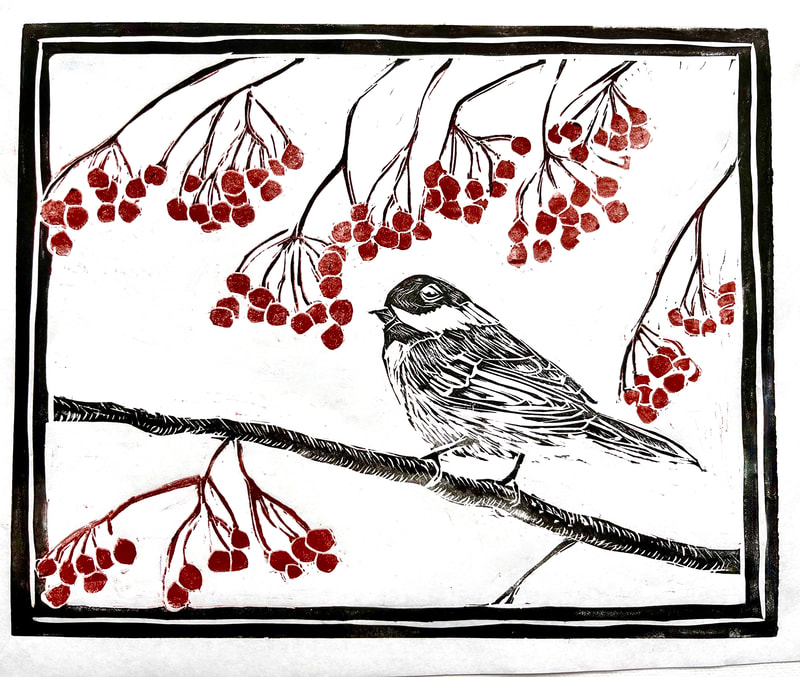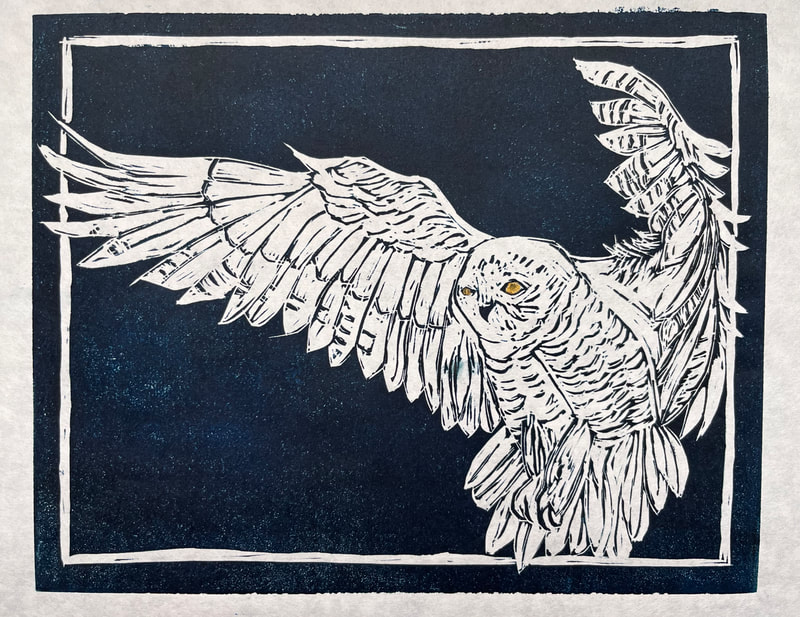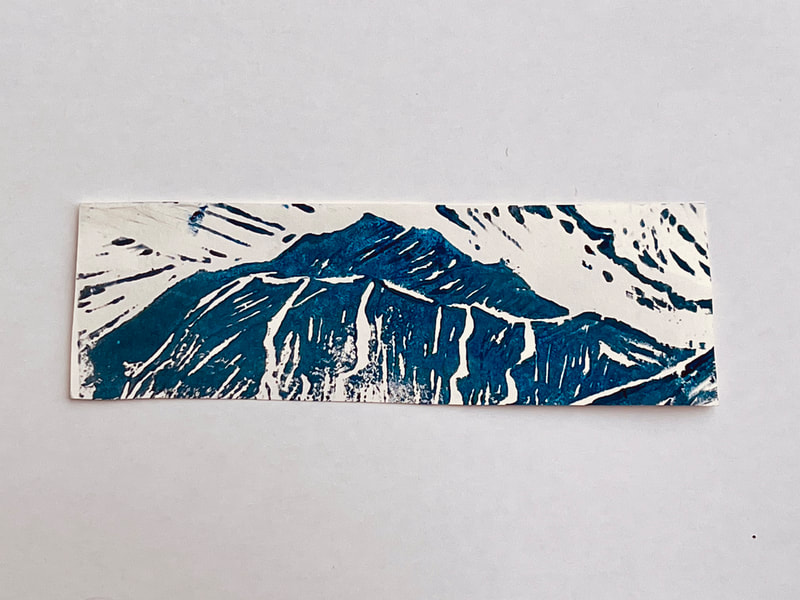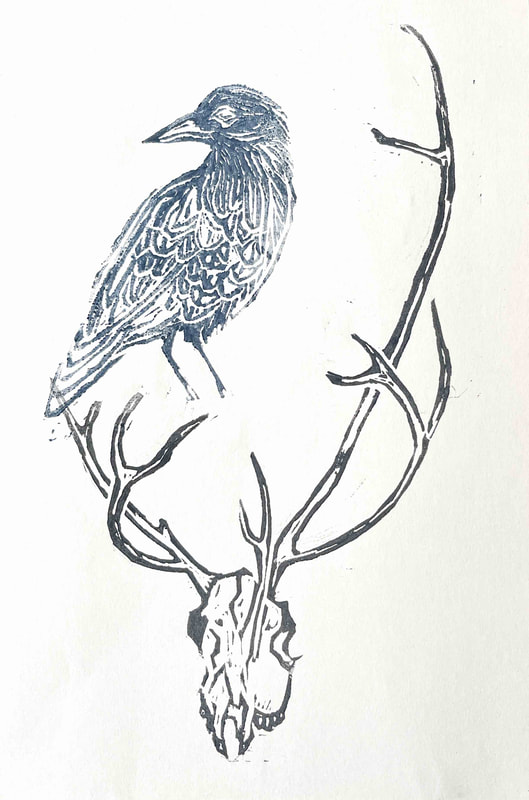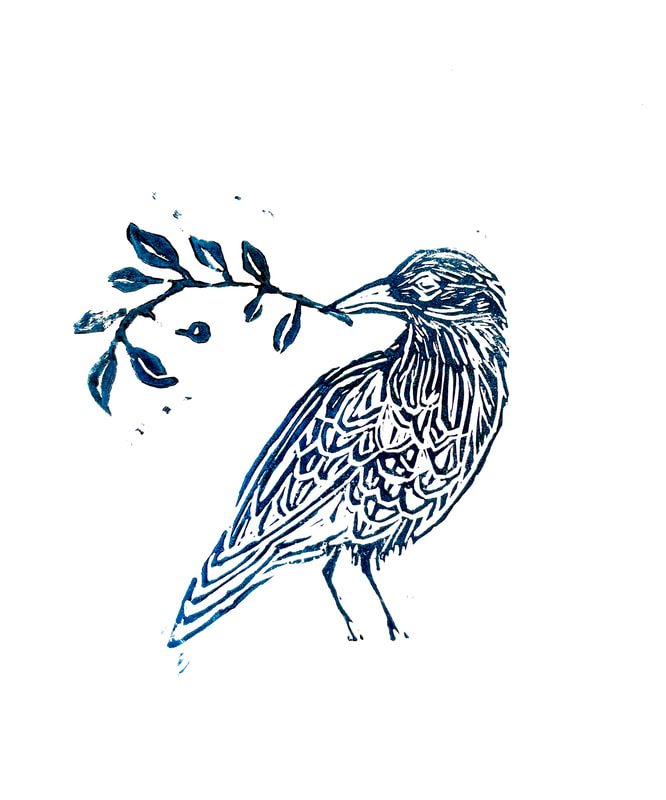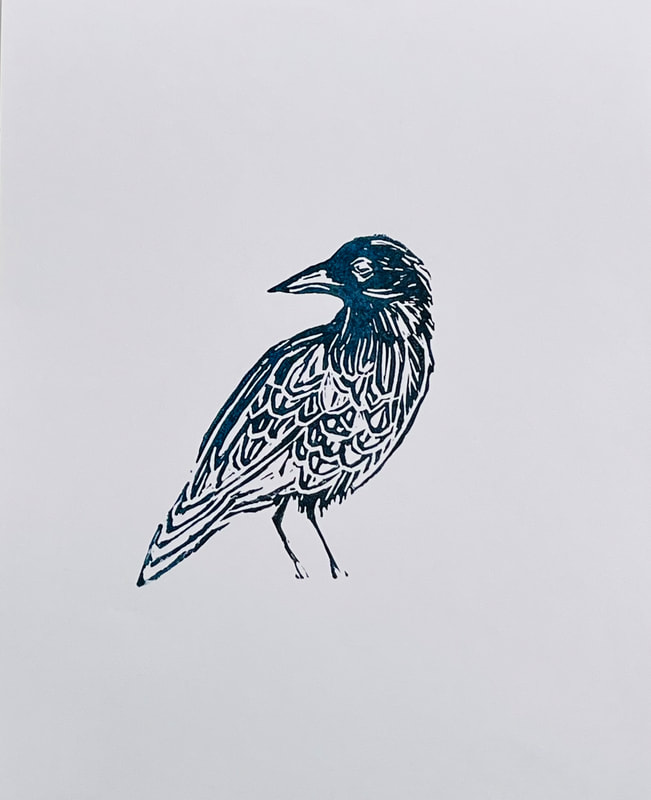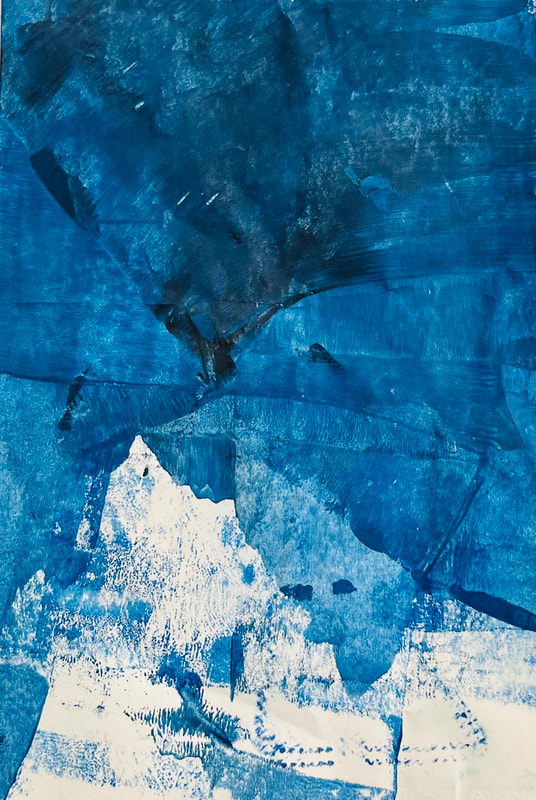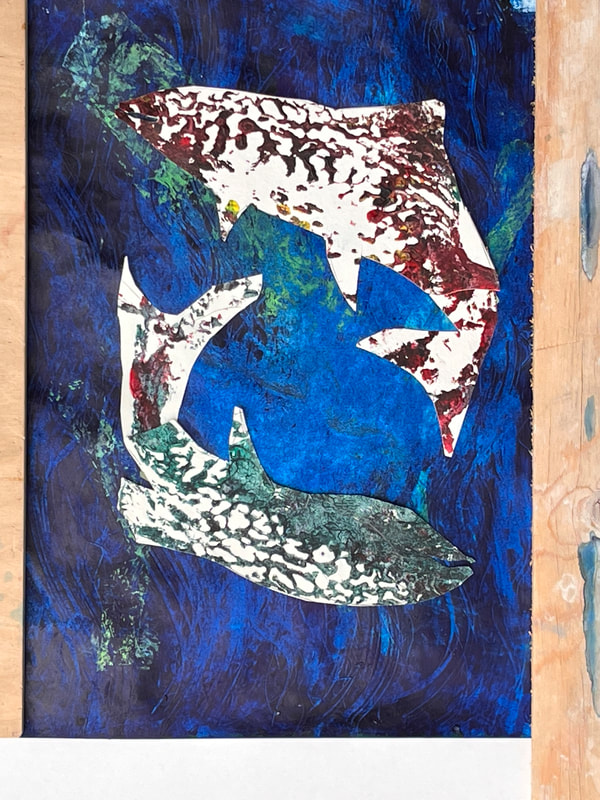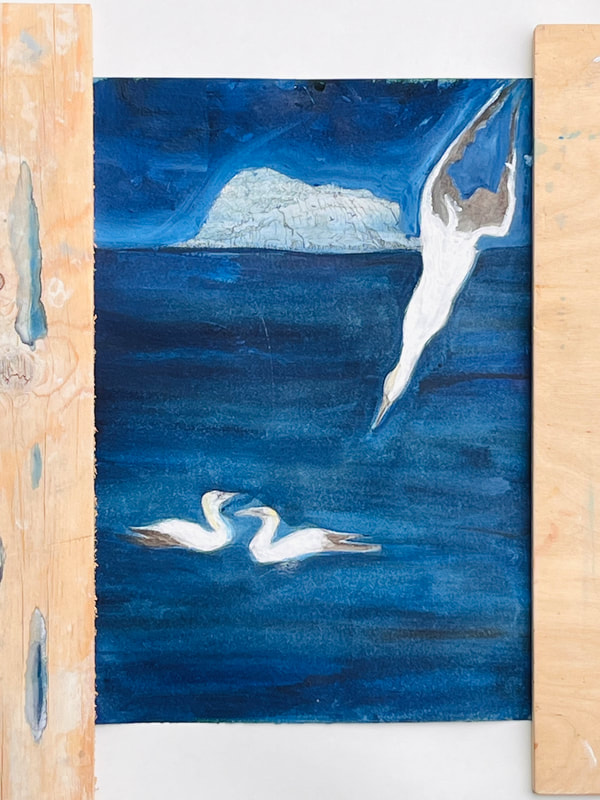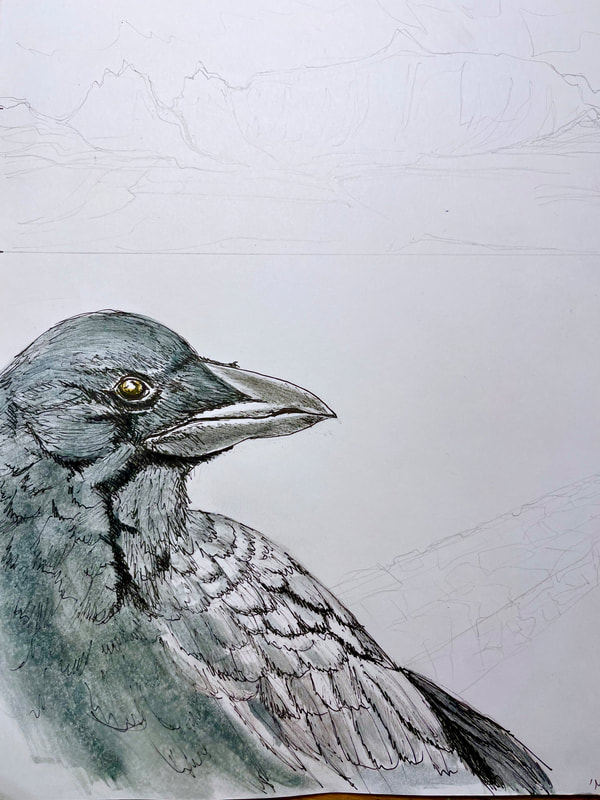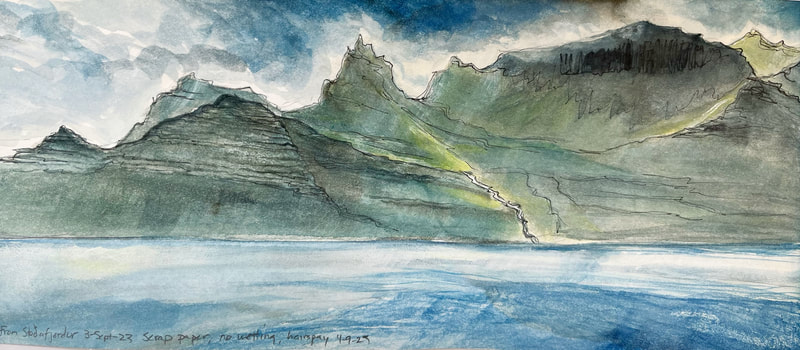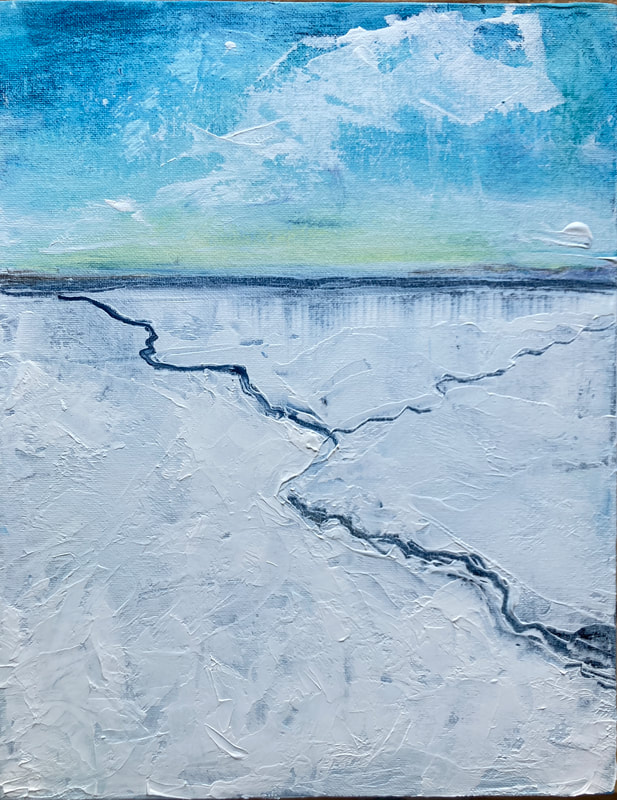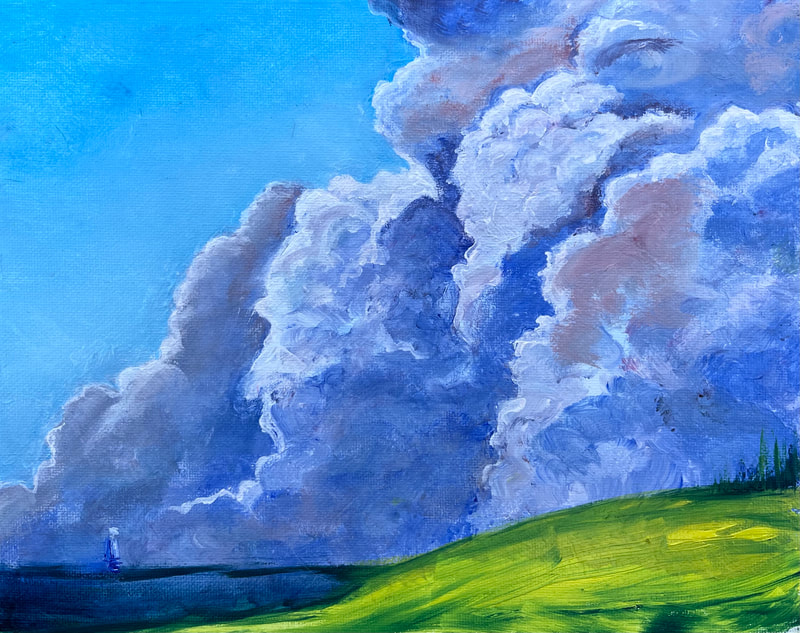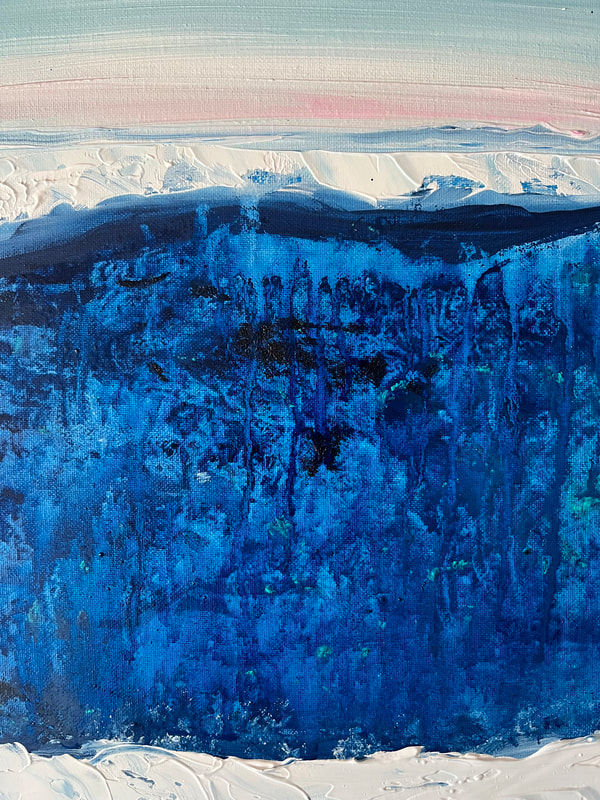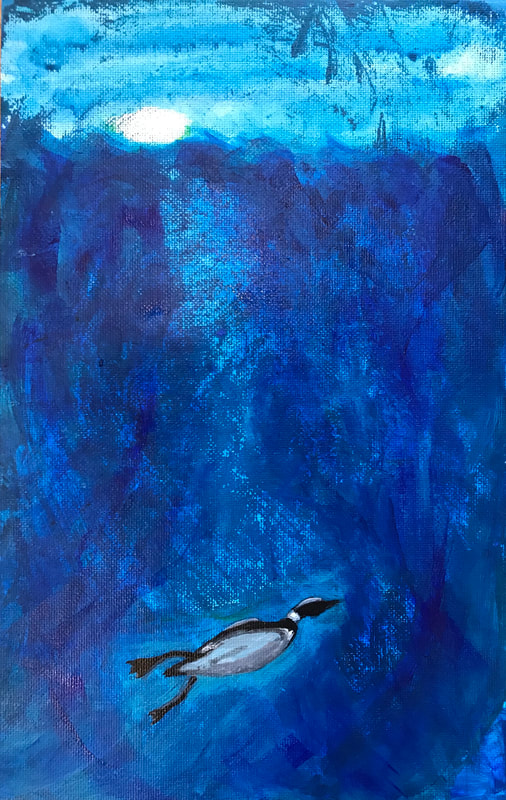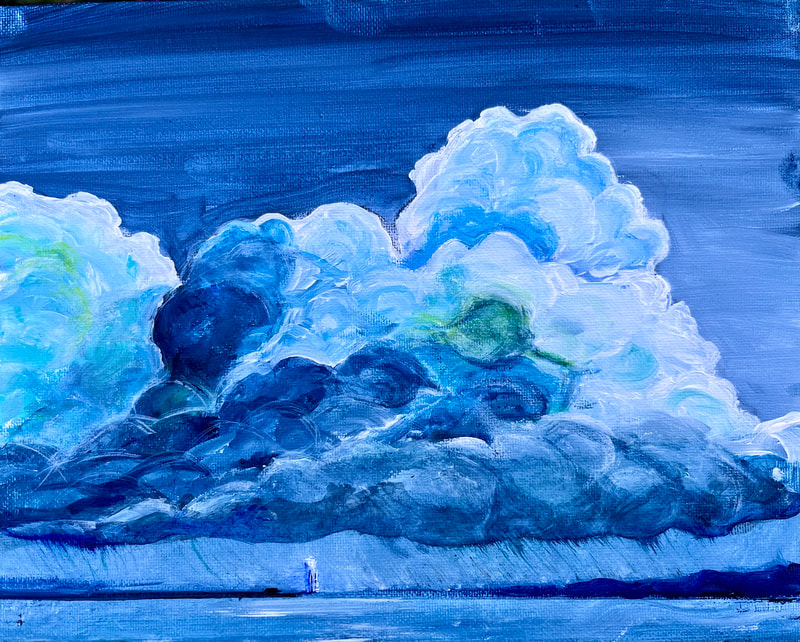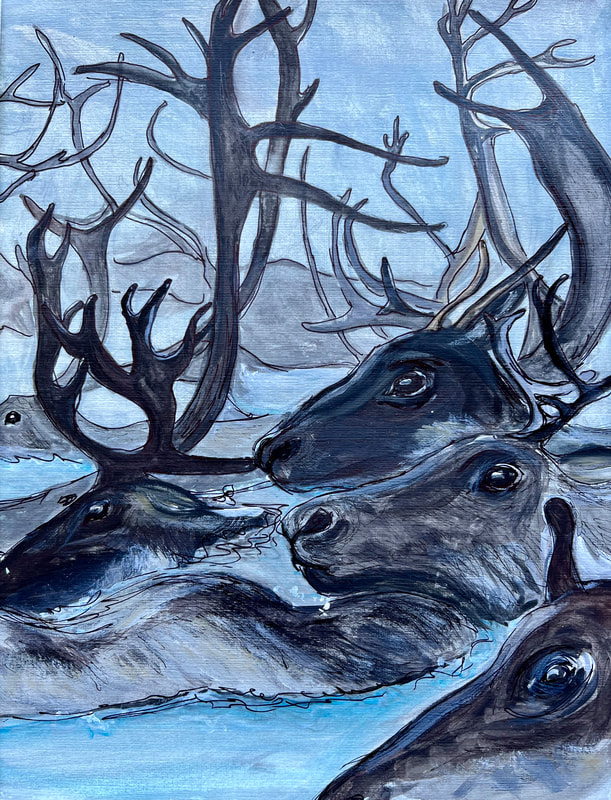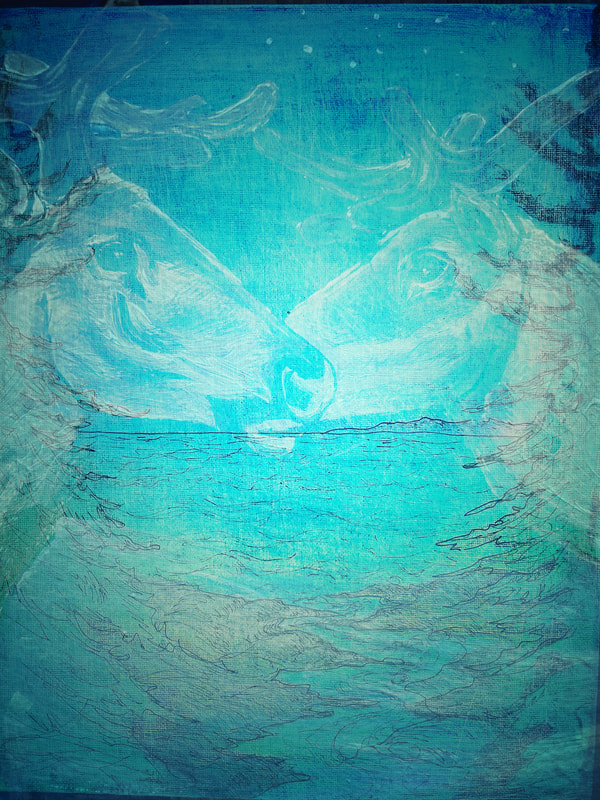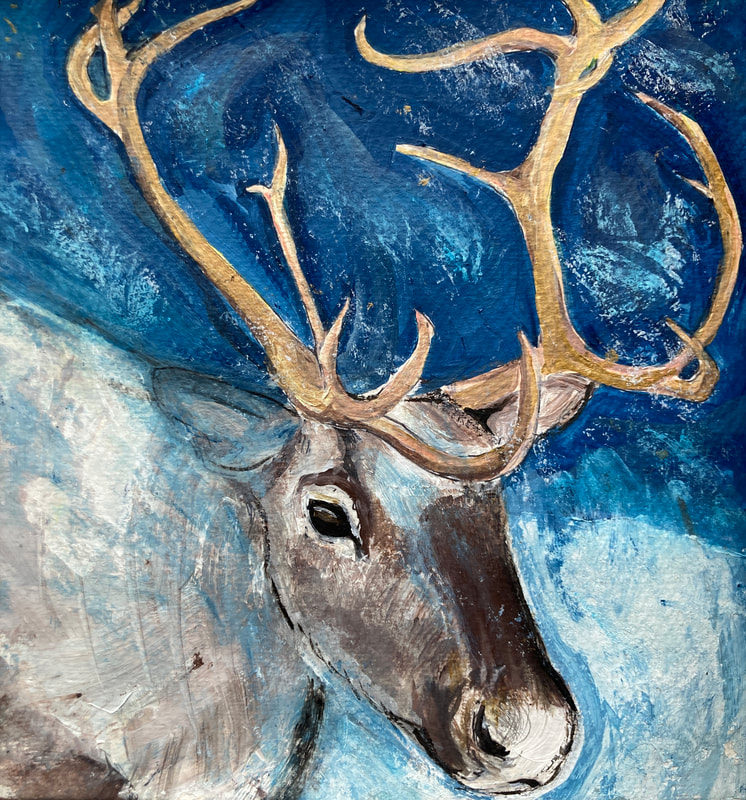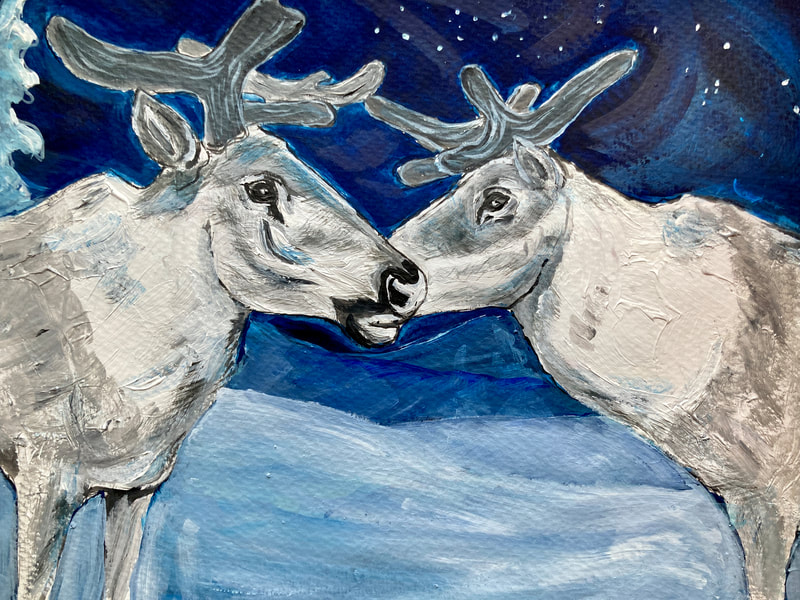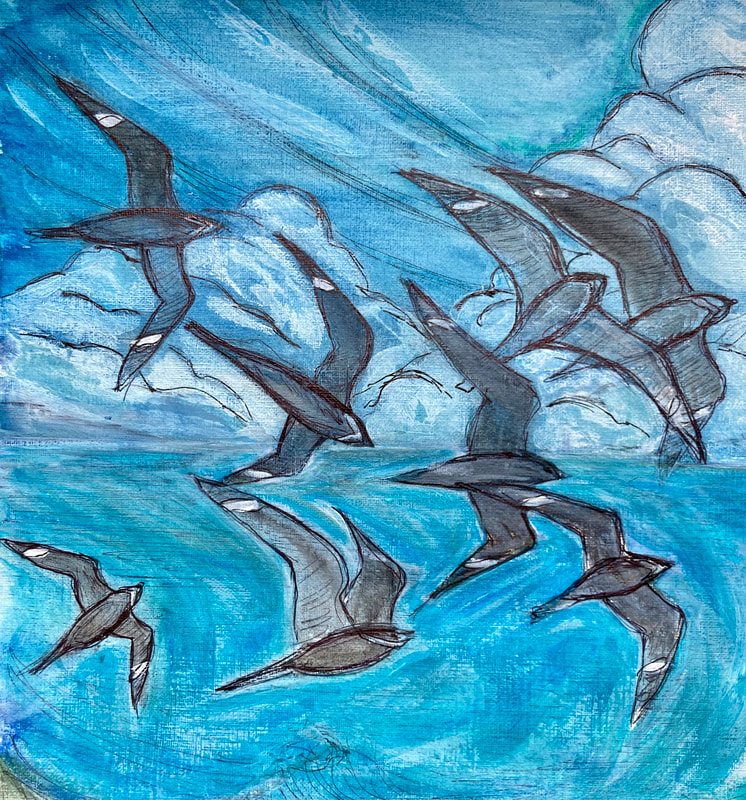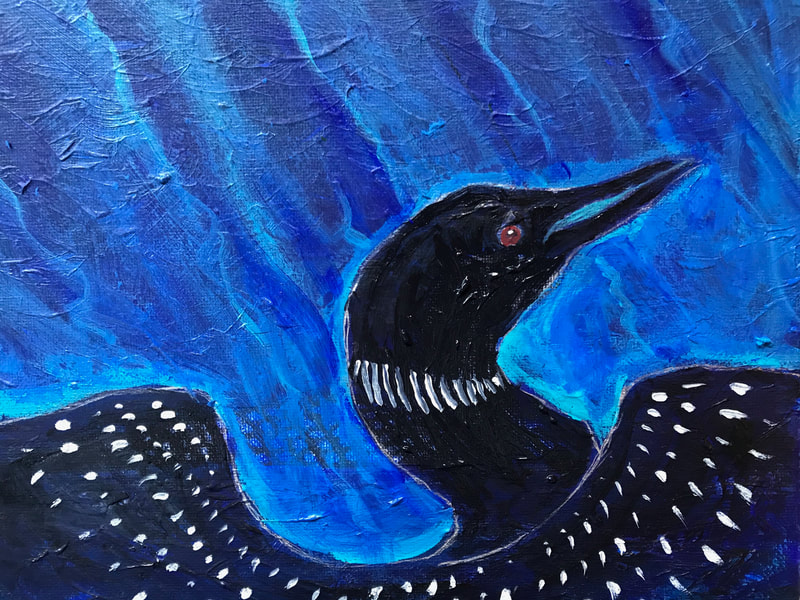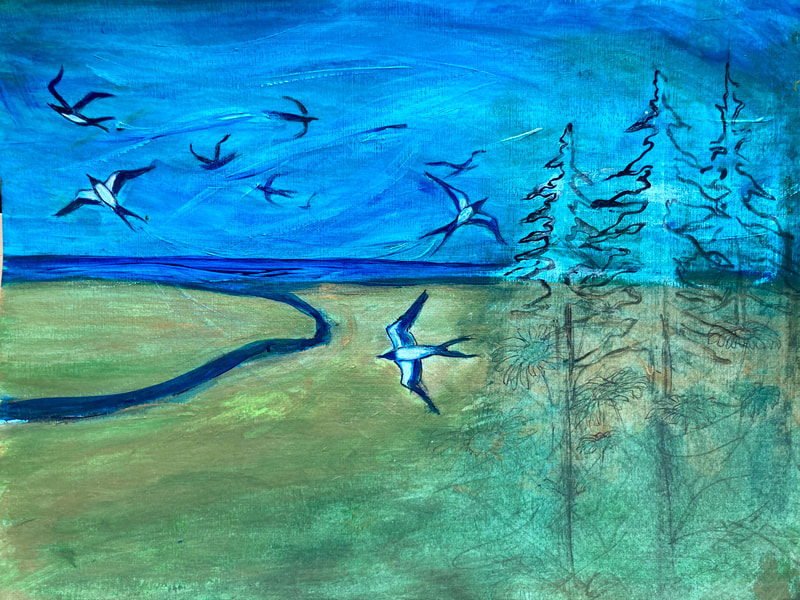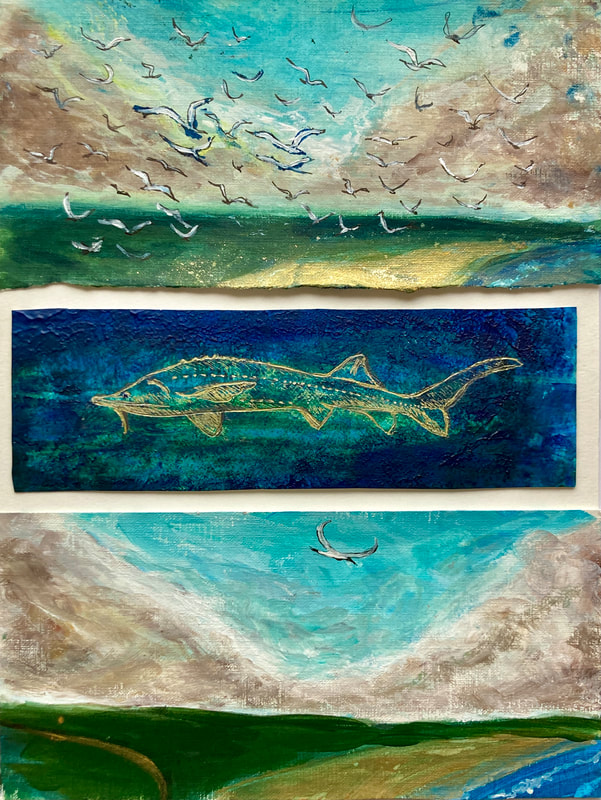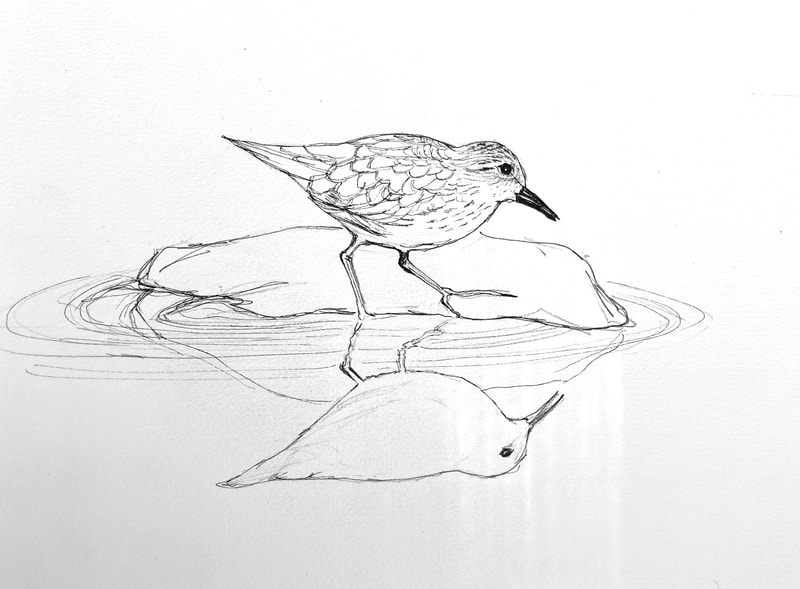I am an interdisciplinary ecological historian and visual artist whose work fuses storytelling, visual art, and environmental history to grapple with the unsettling contradictions of climate change in the boreal north. I work with many ecologists, engaging as best I can with their scientific research.
My paintings convey changes in cold regions, where the waters are rising, forests are dying, fire cycles are changing, wildlife is vanishing, and people are struggling. But these are the places that we still love, places that remain heartbreakingly beautiful even as they undergo massive transformation.
I was trained as an ecologist, and for the past two decades, my academic research has explored the climate and ecological histories of northern ecosystems. I returned to visual arts in 2019 while on sabbatical at the Center for Environmental Futures in Oregon, where I was supported by a Mellon Foundation fellowship and immersed in a community of artists, writers, and scholars exploring environmental change.
I currently focus on linocut printmaking--an art form very similar to traditional woodcut prints, except using a sheet of linoleum. These hand-pulled, limited edition prints are available on request. My earlier work was typically in acrylic or oil.
You can view my art resume here.
My paintings convey changes in cold regions, where the waters are rising, forests are dying, fire cycles are changing, wildlife is vanishing, and people are struggling. But these are the places that we still love, places that remain heartbreakingly beautiful even as they undergo massive transformation.
I was trained as an ecologist, and for the past two decades, my academic research has explored the climate and ecological histories of northern ecosystems. I returned to visual arts in 2019 while on sabbatical at the Center for Environmental Futures in Oregon, where I was supported by a Mellon Foundation fellowship and immersed in a community of artists, writers, and scholars exploring environmental change.
I currently focus on linocut printmaking--an art form very similar to traditional woodcut prints, except using a sheet of linoleum. These hand-pulled, limited edition prints are available on request. My earlier work was typically in acrylic or oil.
You can view my art resume here.
SELECTED RECENT LINOCUTS
Birds of the Keweenaw Linocut series, hand printed, 8X10" print on 9"X12" Japanese rice paper
Iceland Art
I've made 3 trips to Iceland to do research in landscape change and reindeer conservation. In Fall 2023, I spent a month at the Fish Factory Art Residency in east Iceland, studying printmaking and painting in Stöðvarfjörður. It was an extraordinary experience.
TIPPING POINTS:
LAKE SUPERIOR IN A TIME OF CLIMATE CHANGE
Paintings in my Lake Superior series "Tipping Points: Lake Superior in a Time of Climate Change" are intended to become illustrations in a work of visual nonfiction (similar to a graphic history or graphic novel) that explores how we can create hope, resiliency, and recovery in the world’s largest freshwater lake—which is also one of the fastest warming lakes in the world. (These won't be like comic strips, much as I love those formats for graphic novels). Instead, they will be illustrated narratives that combine paintings, text, and storytelling. Some of my favorite models include Lauren Redniss's extraordinary work, particularly in Radioactive, and Timothy Snyder's graphic collaboration with Nora Krug in On Tyranny.
As I explored in my two books about Lake Superior’s environmental history (Sustaining Lake Superior 2017, and Climate Ghosts 2021), Lake Superior is warming at a terrifying rate. It's actually one of the fastest warming lakes in the world. Water levels are becoming more variable, ice is melting, and migratory wildlife such as lake sturgeon and woodland caribou are struggling.
But these are places that remain extraordinarily beautiful even as they undergo massive transformation. This is the core tension I explore in my painting and writing: how can such tragedy also be so beautiful? Paintings in this series explore the contradictions of such beauty in a time of climate change. I use a palette of blues and paint realistic images of conventional landscape beauty, integrated with text that attempts to shatter the viewer's initial sense of calm .Storms, melting ice, retreating snow, flooded coasts: they are all surprisingly lovely, even though the changes they represent are terrifying.
The pieces with museum labels painted on them are part of a series that explores tipping points of today, viewed from a future museum visitor's perspective. For more on this project, please go to this storymap.
The graphic novel that these paintings will illustrate takes readers on an imaginative journey into the world we will bequeath to future generations. How will future residents of the Lake Superior look back at traces from our snowy world? What can we do now to protect our communities, both human and more-than-human? How can we embrace fearlessly the melting world, even as we work to protect it?
I thank The Well-Read Raccoon for hosting this exhibition April 15-July 15, 2023 in Houghton, Michigan. A few paintings from the exhibition are included below. Click on thumbnail images in the galleries below to see the full painting or sketch and (in some cases) a brief description.
As I explored in my two books about Lake Superior’s environmental history (Sustaining Lake Superior 2017, and Climate Ghosts 2021), Lake Superior is warming at a terrifying rate. It's actually one of the fastest warming lakes in the world. Water levels are becoming more variable, ice is melting, and migratory wildlife such as lake sturgeon and woodland caribou are struggling.
But these are places that remain extraordinarily beautiful even as they undergo massive transformation. This is the core tension I explore in my painting and writing: how can such tragedy also be so beautiful? Paintings in this series explore the contradictions of such beauty in a time of climate change. I use a palette of blues and paint realistic images of conventional landscape beauty, integrated with text that attempts to shatter the viewer's initial sense of calm .Storms, melting ice, retreating snow, flooded coasts: they are all surprisingly lovely, even though the changes they represent are terrifying.
The pieces with museum labels painted on them are part of a series that explores tipping points of today, viewed from a future museum visitor's perspective. For more on this project, please go to this storymap.
The graphic novel that these paintings will illustrate takes readers on an imaginative journey into the world we will bequeath to future generations. How will future residents of the Lake Superior look back at traces from our snowy world? What can we do now to protect our communities, both human and more-than-human? How can we embrace fearlessly the melting world, even as we work to protect it?
I thank The Well-Read Raccoon for hosting this exhibition April 15-July 15, 2023 in Houghton, Michigan. A few paintings from the exhibition are included below. Click on thumbnail images in the galleries below to see the full painting or sketch and (in some cases) a brief description.
Caribou and Reindeer Migrations
Reindeer tie the world together. They have been central to human life across the global north for millennia, for they allowed people to expand into Arctic regions as the glaciers retreated. And now, they are crucial partners in the fight against Arctic climate change, because their browsing can keep shrubs at bay, thus increasing albedo and cooling local climates.
But across the boreal and the Arctic, reindeer and caribou populations are now crashing. They have retreated from roughly half their 19th century range, and their populations have dropped by 56% in the past decade. Translocating herds to viable habitats may become critical as warming reduces the utility of current range. Yet how do we move reindeer—and other threatened migratory species—in a rapidly changing world with complex geopolitical boundaries? In another visual history project underway, I explore the colonial and post-colonial histories of reindeer/caribou translocations.
But across the boreal and the Arctic, reindeer and caribou populations are now crashing. They have retreated from roughly half their 19th century range, and their populations have dropped by 56% in the past decade. Translocating herds to viable habitats may become critical as warming reduces the utility of current range. Yet how do we move reindeer—and other threatened migratory species—in a rapidly changing world with complex geopolitical boundaries? In another visual history project underway, I explore the colonial and post-colonial histories of reindeer/caribou translocations.
Feather by Feather: Birds of the Great Lakes
People have viewed birds as sentinels of change for millennia. What do birds now tell us about restoration and recovery in the Great Lakes, and about the continuing challenges we face with our more-than-human kin? You can click on thumbnails below to see larger images, or scroll through the StoryMap.









